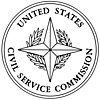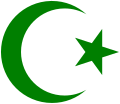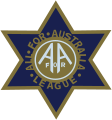This article has multiple issues. Please help improve it or discuss these issues on the talk page. (Learn how and when to remove these messages)
|
Star polygons and polygonal compounds are the basis for numerous figures of significance in arts and culture. The figure may be the border or interior of the polygon, or one or more closed polygonal paths that include all of the border and also have some legs crossing the interior. The name is derived from the polygon's similarity to the diffraction spikes of astronomical stars, but specific uses may exploit the connection or not. Stars often represent the unity of states within a country when they are used as a part of the flag.
Emblematic use
Main article: Star (heraldry)- In heraldry, a mullet is a star with straight arms and typically five points. A star with wavy rather than straight rays is called an estoile. The mullet, used as an heraldic charge, is the ensign of knightly rank, and every order of knighthood incorporates this symbol in some way. It has traditionally been used in British heraldry as a mark of cadency for the third son.
- In Christian art, St. Bruno bears a star on his breast; Saint Dominic, Saint Humbert and Saint Peter of Alcantara have a star on their head or forehead.
- The star with six (or less commonly five, sometimes seven) points is associated with law enforcement in the United States, and forms the basis of the sheriff's badge.
Three-pointed stars

The three-pointed star is used much less often than other types of stars. but it appears in one of the versions of the flag of the International Brigades in the Spanish civil war. It also appears in the symbol of the Mercedes-Benz car manufacturer.
Four-pointed stars

Several varieties of four-pointed stars were used in cultures around the world:
The 1914-15 star campaign medal of the British army was based on a four-pointed star. A compass rose in the form of a four pointed-star also appears in the flag of NATO and the flag of the country of Aruba. The seal of the (now cancelled) United States Civil Service Commission included a four-pointed star between the years 1963-1979. Four-pointed stars also appears in the symbols of the Subaru car company and Philips corporation.
Five-pointed stars
Main article: Five-pointed star
The five-pointed star, if drawn with points of equal length and angles of 36° at each point, is sometimes termed a golden five pointed star. If the colinear edges are joined, a pentagram is produced, which is the simplest of the unicursal star polygons, and a symbol of mystical and magical significance. The golden five-pointed star is a very common ideogram in the western world, and has particularly strong associations with military power and war. Many communist countries (such as China and Vietnam) and symbols also incorporate five-pointed stars.
The five-pointed star appears in the flags of 35 countries, and also appears commonly in the heraldry of the United States, and stands in contrast to the vexillologically rarer seven-pointed star.
The five-pointed star occurs in conjunction with a crescent in the flags of several countries to symbolize Islam, appearing for example as part of the symbol of the Ottoman Empire.
In philately, the five-pointed star signifies stamps that have not been postmarked.
The five-pointed star is used as the symbol of the People Nation alliance of gangs from Chicago. Blood gangs who originated from New York, known as the United Blood Nation, also use this as a symbol as they have emulated the People Nation alliance.

In the Armenian Pantheon, there is a goddess called Astlik/Astghik. In the Armenian language Astgh means star, Astghik - Little Star. Compared with Ishtar, Astara, this goddess' sign should have been the (probably)eight-pointed star.
-
 The pentagram, a five-pointed star drawn with five straight strokes
The pentagram, a five-pointed star drawn with five straight strokes
-
 The star and crescent symbol is mostly shown with five-pointed stars in modern flags, but in the oldest Ottoman flag of this design as well as the flag of Azerbaijan, the star is eight-pointed.
The star and crescent symbol is mostly shown with five-pointed stars in modern flags, but in the oldest Ottoman flag of this design as well as the flag of Azerbaijan, the star is eight-pointed.
-
 The 1777 Flag of the United States had 13 stars of an unspecified number of points.
The 1777 Flag of the United States had 13 stars of an unspecified number of points.
Six-pointed stars
Several varieties of six-pointed stars are used in cultures around the world:
- If the collinear edges of a regular six-pointed star are connected, so that two interlaced triangles are formed, a symbol results that is variously known as the hexagram, Star of David, or Shield of David (Magen David). This symbol is most commonly associated with Judaism. It is also used in Christianity, Islam and Hinduism, but less frequently.
- The Ahmadiyya flag, Lawa-e-Ahmaddiyat, contains a six-pointed star, adjacent to a crescent.
- The Star of Life, which is a six-armed cross.
- The municipal flag of Chicago has four six-pointed stars.
- in the flag of Nagaland the six-pointed Star of Bethlehem is a symbol of the Christian identity of the Naga people.
- German and German-American hex signs and barn stars often incorporate both five- and six-pointed stars as central themes.
- The six-pointed star is used as the symbol for the Folk Nation alliance of gangs from Chicago. Crip gang members tend to use this symbol also.
Apart from these, six-pointed star formations are rare as an ideograph in Western cultures except in the case of law enforcement badges. In astrology, some formations of a six-pointed star can signify fixed stars. In some rare instances, it can signify the date of birth on a gravestone, synonymous with the five-point star.
-
 Star of David
Star of David
-
 Ahmadiyya flag
Ahmadiyya flag
-
 All for Australia League emblem
All for Australia League emblem
-
 Chicago Flag
Chicago Flag
-
 Flag of Northern Ireland, 1953–1972
Flag of Northern Ireland, 1953–1972
-
 Flag of Nagaland with the Star of Bethlehem symbol
Flag of Nagaland with the Star of Bethlehem symbol
Seven-pointed stars
Political
A seven-pointed star appears in the flag and heraldic symbolism of Australia. In the Australian context, the seven points (also known as the Commonwealth Star, the Federation Star, the Seven Point Star, or the Star of Federation) is a seven-pointed star symbolising the Federation of Australia which came into force on 1 January 1901. Six points of the Star represent the six original states of the Commonwealth of Australia, while the seventh point represents the territories.
The seven-pointed stars stand in contrast to the vexillologically more conventional five-pointed stars.
The Seal of the Cherokee Nation has an acute gold seven-pointed star in its seal.
The seven-pointed star is also used as a symbol of the Trinitarios gang from New York City.
Heptagram
Main article: HeptagramA heptagram or septagram is a seven-pointed star drawn with seven straight strokes. There are two kinds of heptagrams:
- Acute heptagram, the {7/3} star polygon.
- Obtuse heptagram, the {7/2} star polygon.
Eight-pointed stars
Political
-
 1959 Flag of Iraq
1959 Flag of Iraq
-
 Flag of Azerbaijan
Flag of Azerbaijan
-
 Flag of Ha'il state (1834–1921)
Flag of Ha'il state (1834–1921)
-
 Flag of Minnesota (2024-present)
Flag of Minnesota (2024-present)
Other
The eight-pointed star is widely used in the Arabic states in decorative art,. It is sometimes similar to the Star of Lakshmi formed from overlapping squares but may also appear in the form of the Rub el Hizb which adds a central circle to the design.
A two-color, 8-pointed star associated with the American Friends Service Committee and other Quaker service groups since the 1870s is sometimes called "the Quaker star".
Nine-pointed stars
A nine-pointed star is the most common symbol of the Baháʼí Faith, the number nine being significant in the religion.
Eleven-pointed stars
The flag of the Federation of Malaya used the eleven-pointed star from 1950 until 1963, with the star representing the 11 member states of the federation.
Twelve-pointed stars
The flag of Nauru uses a twelve-pointed star representing the 12 tribes on the island.
Fourteen-pointed stars
In the Church of Nativity in Bethlehem the traditionally location of the birth of Jesus is marked by a silver star with 14 points that represents the three sets of 14 generations in the genealogy of Jesus. The flag of Malaysia uses the Federal Star, a fourteen-pointed star representing the unity between the 13 member states and the federal government.
See also
References
- Fox-Davies, Arthur Charles; Graham Johnston (2004) . A Complete Guide to Heraldry. Kessinger Publishing. pp. 295–296. ISBN 1-4179-0630-8.
- Volborth, Carl Alexander von (1981). Heraldry: Customs, Rules and Styles. Poole, England: Blandford Press. p. 80. ISBN 0-7137-0940-5.
- Brewer, E. Cobham (1994). "Star". The Dictionary of Phrase and Fable. Ware, Hertfordshire: Wordsworth Editions Ltd. ISBN 1-85326-300-1.
- Oviedo de Valeria, Jenny (2 August 1994). "The International Brigades in the Spanish War 1936-1939: Flags and Symbols". Educación matemática. 6 (2): 73–86. doi:10.24844/em0602.06. ISSN 2448-8089.
- About the 1914-15 Star, UK Parliament site
- "Executive Order 11096—Establishing a Seal for the United States Civil Service Commission | The American Presidency Project". www.presidency.ucsb.edu. Retrieved 10 March 2024.
- The five-pointed star Archived 11 November 2006 at the Wayback Machine from Liungman, Carl G. (2004). Symbols: Encyclopedia of Western Signs and Ideograms. HME Publishing. ISBN 91-972705-0-4.. Retrieved 19 July 2006.
- "The History of the Stars and Stripes". Federal Citizen Information Center. Retrieved 15 September 2009.
- The sixpointed star Archived 11 November 2006 at the Wayback Machine from Liungman, Carl G. (2004). Symbols: Encyclopedia of Western Signs and Ideograms. HME Publishing. ISBN 91-972705-0-4.. Retrieved 19 July 2006.
- Graham, Dr. O.J. The Six-Pointed Star: Its Origin and Usage 4th ed. ISBN 0-9689383-0-2
External links
- Moroccan Islamic Patterns: The Eight-Point Star Examining the symbolic meaning of the eight-point star (khatam) in Islamic ornamentation.











